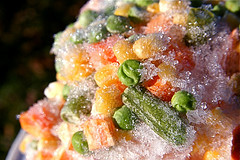What to Do When Your Refrigerator's Waaay Too Cold
 Okay, you know the weather's getting warmer but this is ridiculous. You really don't need frozen lettuce and frosted eggs to help you keep your cool. In fact, it sounds like you've got a problem on your hands. What should you do when your refrigerator is too cold -- I mean, waaay too cold and turning all your food into icicles? Here's a simple step-by-step plan of action to track down the source of the problem and get the right refrigerator repair.
Okay, you know the weather's getting warmer but this is ridiculous. You really don't need frozen lettuce and frosted eggs to help you keep your cool. In fact, it sounds like you've got a problem on your hands. What should you do when your refrigerator is too cold -- I mean, waaay too cold and turning all your food into icicles? Here's a simple step-by-step plan of action to track down the source of the problem and get the right refrigerator repair.
Check the Appliance's Outside First
The fridge door may simply not be closing completely. This wreaks havoc with your refrigerator's thermostat. The difficulty could be due to an uneven floor and not to any mechanical malfunction. Move the fridge a few inches and see whether that does the trick.
Another potential DIY fix is to try tightening the door's hinges with a screwdriver.
Next, have a look at the rubber gasket that is supposed to seal your refrigerator door shut. If it is loose or torn, you may have to replace it.
Clean the Fridge
Before you move on to the complex inner workings of your refrigerator, roll up your sleeves and apply a little old fashioned elbow grease to the problem. Pull the fridge away from the wall and vacuum the condenser coils on the back to make it run more efficiently. Defrost the freezer and wipe out both the freezer area and the refrigerator section, using a cloth moistened with a 4:1 solution of warm water and vinegar (food-safe, vinegar disinfects and deodorizes).
This is also a good time to clear the defrost drain as part of your refrigerator maintenance.
Set the Correct Temperature
It's important to set your refrigerator below 40 degrees to protect food against spoilage. However, go any lower than 32 degrees and you've reached the official freezing point. Popular wisdom says that you should decrease the temperature when summer begins; however, if you consistently air-condition your home, this may not be necessary. Make sure your fridge temperature is in the range of 35-38 degrees, while a freezer setting of minus 10 to minus 20 degrees will keep frozen food at its best. If the thermostat is unclear, buy an inexpensive refrigerator thermometer to check.
Help the Cold Air to Circulate
A full-ish fridge and freezer are the most efficient temperature-wise. (Placing a few containers of water in a half-empty appliance will help maintain optimal cooling.) Just make sure that they're not so overstuffed that they keep the cold air from circulating adequately.
Speaking of proper circulation, it can be blocked by just one item. In my household, the most likely culprit is a bag of frozen peas, which has slumped over and is leaning cozily on top of the vent of the circulating fan.
FASCINATING FRIDGE TRIVIA: If you bought the refrigerator recently and still have the owner's manual, or if you look it up online, you can actually see a diagram of the air flow pattern in your particular model.
Find Mechanical or Electrical Problems
Once the refrigerator is clean and the vent is not physically blocked, perform this scientific test. Put your hand inside the fridge and see whether you can feel the flow of cold air from the freezer. If not, the circulating fan may not be working.
Other components to investigate are the thermostat itself and in a digital refrigerator, the computer board.
If any of these seems to be faulty, find out whether your warranty will cover the cost of hiring a pro to repair your fridge.
Laura Firszt writes for networx.com.
Looking for a Pro? Call us (866) 441-6648

Handyman Average Costs
Handyman Services Experiences

Light Fixture Installation By An Electrician With A Good Eye For Detail

Whole House Fan Installation Saves Me Money On Electricity



